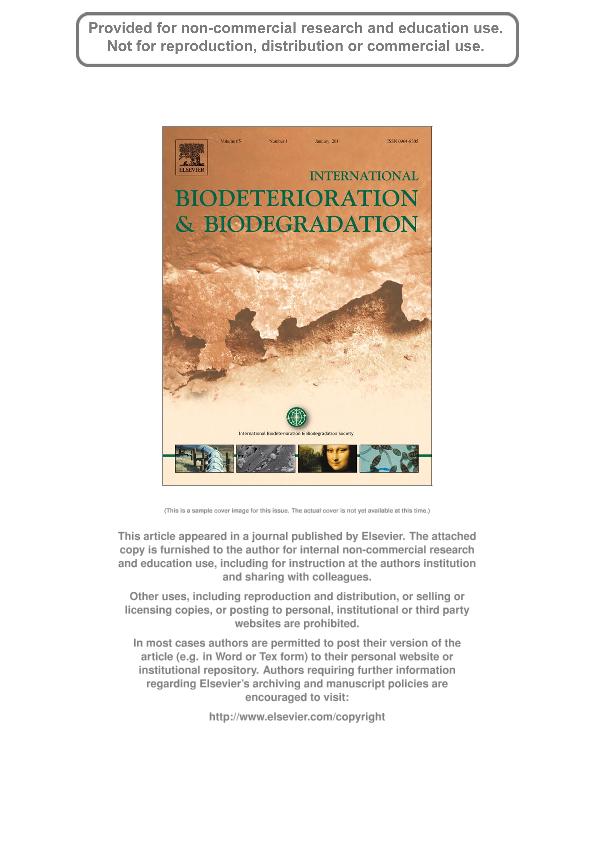Mostrar el registro sencillo del ítem
dc.contributor.author
Colin, Veronica Leticia

dc.contributor.author
Villegas, Liliana Beatriz

dc.contributor.author
Abate, Carlos Mauricio

dc.date.available
2018-03-02T20:25:39Z
dc.date.issued
2012-04
dc.identifier.citation
Colin, Veronica Leticia; Villegas, Liliana Beatriz; Abate, Carlos Mauricio; Indigenous microorganisms as potential bioremediators for environments contaminated with heavy metals; Elsevier; International Biodeterioration and Biodegradation; 69; 4-2012; 28-37
dc.identifier.issn
0964-8305
dc.identifier.uri
http://hdl.handle.net/11336/37735
dc.description.abstract
Heavy metal pollution is one the most serious environmental problems facing our planet today, and immediate solutions are needed. Heavy metals such as copper (Cu) and chromium (Cr) play an important role as trace elements in biochemical reactions, but these metals are toxic at higher concentrations. In our region, mining and industrial activities have led to large-scale copper contamination in the environment. All organisms have homeostasis mechanisms for this metal, but when these controls fail or are exceeded several toxicological processes can develop.Problems involving Cr contamination are related to the fact that Argentina is an important world producer of leather. A chromium compound is used as a tanning agent, which has resulted in severe contamination near tanneries, with a mix of Cr(III) and Cr(VI). At present, the conventional technologies used to remove heavy metals from the environment involve physicochemical processes, which are costly and require large amounts of energy and specialized equipment. However, microbe-based removal is now considered to be an effective alternative method to the conventional processes and is receiving greater levels of interest for potential uses in bioremediation.This review discusses the toxic effects of Cu and Cr on the environment and on human health, as well as possible approaches for bioremediation of these metals using native microbes from our region.
dc.format
application/pdf
dc.language.iso
eng
dc.publisher
Elsevier

dc.rights
info:eu-repo/semantics/openAccess
dc.rights.uri
https://creativecommons.org/licenses/by-nc-nd/2.5/ar/
dc.subject
Actinobacteria
dc.subject
Bioremediation
dc.subject
Heavy Metals
dc.subject
Indigenous Microorganisms
dc.subject
Native Yeasts
dc.subject.classification
Otras Ciencias Biológicas

dc.subject.classification
Ciencias Biológicas

dc.subject.classification
CIENCIAS NATURALES Y EXACTAS

dc.title
Indigenous microorganisms as potential bioremediators for environments contaminated with heavy metals
dc.type
info:eu-repo/semantics/article
dc.type
info:ar-repo/semantics/artículo
dc.type
info:eu-repo/semantics/publishedVersion
dc.date.updated
2018-03-02T15:00:05Z
dc.journal.volume
69
dc.journal.pagination
28-37
dc.journal.pais
Países Bajos

dc.journal.ciudad
Amsterdam
dc.description.fil
Fil: Colin, Veronica Leticia. Consejo Nacional de Investigaciones Científicas y Técnicas. Centro Científico Tecnológico Conicet - Tucuman. Planta Piloto de Procesos Industriales Microbiologicos; Argentina
dc.description.fil
Fil: Villegas, Liliana Beatriz. Consejo Nacional de Investigaciones Científicas y Técnicas. Centro Científico Tecnológico Conicet - Tucuman. Planta Piloto de Procesos Industriales Microbiologicos; Argentina
dc.description.fil
Fil: Abate, Carlos Mauricio. Consejo Nacional de Investigaciones Científicas y Técnicas. Centro Científico Tecnológico Conicet - Tucuman. Planta Piloto de Procesos Industriales Microbiologicos; Argentina
dc.journal.title
International Biodeterioration and Biodegradation

dc.relation.alternativeid
info:eu-repo/semantics/altIdentifier/url/http://www.sciencedirect.com/science/article/pii/S0964830511002514
dc.relation.alternativeid
info:eu-repo/semantics/altIdentifier/doi/http://dx.doi.org/10.1016/j.ibiod.2011.12.001
Archivos asociados
